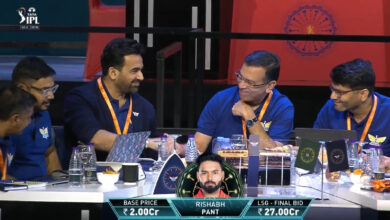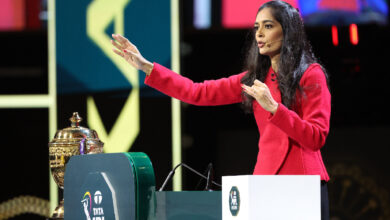How India had perfect T20 game with bat, with three quick-fire fifties and a blitz of a cameo | Cricket News

Batsmen in the T20 format look to be out in the middle for a good time, not necessarily a long time. It was what the Indians managed in the second game of the five-match series against Australia, a 44-run win giving them a 2-0 lead.Yashasvi Jaiswal (53 off 25 balls), Ishan Kishan (52 off 32) and Ruturaj Gaikwad (58 off 43) set up the innings before Rinku Singh (31 not out off 9), Suryakumar Yadav (19 off 10) and Tilak Varma (7 not out off 2) put the finishing touches for a mammoth score of 235/4.
During the chase, the Indian bowlers didn’t need to do anything special, other than targeting the stumps and not giving the batsmen room to free their arms. The visitors had a promising start and then a threatening partnership between Marcus Stoinis (45 off 25 balls) and Tim David (37 off 22), but the target always seemed a bit out of reach. Once that stand (81 off 37 balls) was broken, what followed was a swift end to the Aussie challenge, as they ended with 191/9.
In the Indian bowling effort, seamer Prasidh Krishna, who had a difficult game in Vizag on Thursday, bounced back after another difficult start and finished with three wickets for 41 from his four overs. Towards the end of his spell, he was bowling pinpoint yorkers that proved too much for the Australian lower order.
Leg-spinner Ravi Bishnoi (3/32) and left-arm spinner Axar Patel (1/25) showed they understand the demands of this format. They generally bowled at a flat trajectory, hardly ever giving the stumps away and forcing the batsmen to take risks to keep up with the ballooning asking rate.
Skipper Matthew Wade managed some big hits in his unbeaten 42 off 23 balls, but it only managed to bring down the margin of defeat. Freshly-crowned World Cup winners Glenn Maxwell and Adam Zampa came into the Aussie XI, but didn’t have the desired impact. Josh Inglis and Steve Smith, who scored most of their runs in the first game, also had little impact.
On the other hand, the Indian line-up – with five left-handers in their top seven – bred on a heavy IPL diet, showed they know how to go about this format. The series – coming within days of the same two countries contesting the 50-over World Cup final – is an audition of sorts for the global T20 event six months down the road, and showed that India have a strong bench in this format.
Some senior players have not played T20Is since the last World Cup, and it remains to be seen whether they will be brought back into the reckoning, or the selectors will go with a much younger side with a new captain at the helm. On the pace bowling front, the likes of Jasprit Bumrah are likely to be drafted back in, but it’s always useful to put in good performances to remain in the conversation.
Fiery start
On Sunday, after they were sent in, Jaiswal started with a bang and India were 77/1 after the Powerplay, reaching 50 in just 23 balls. Sean Abbott bore the brunt of the assault as Jaiswal greeted him with three consecutive boundaries and two successive sixes off the first five balls he bowled. The fours were all threaded through backward point and short-third, and when Abbott went short, he was pulled disdainfully over deep square-leg. He was gone the time the Powerplay ended, but had inflicted the biggest damage then.
It was not the end of Abbott’s agony for the night. When he came on to bowl the 19th over, Rinku got hold of him with three fours and two sixes off his own, as the seamer bled 56 runs from his three overs, though one of the boundaries went through Smith’s legs at mid-off.
Rinku has now finished off the innings twice in succession – once in a big chase and now batting first. It’s a skill and ability not in abundant supply, and the youngster from Aligarh has well and truly thrown his hat in the ring for a ticket to the Caribbean and the United States next summer.
Kishan made his fortune largely against the spinners and it helped his cause that he had two leg-spinners in Zampa and Tanveer Sangha to target. All but one of his hits to and beyond the boundary came against the tweakers, proving that the left-hander can make the most of a favourable match-up.
In comparison, Gaikwad’s was a steady innings as despite opening the innings, he was the third to reach 50. But he kept rotating strike and came up with timely boundaries, ensuring that the pressure never lifted off the Aussie throats.
The teams now make the long trip to the North-East, with India having the opportunity to seal the series in Guwahati on Tuesday. Australia haven’t fielded World Cup hero Travis Head yet, and it remains to be seen whether they employ all their big guns in a bid to stay alive.







